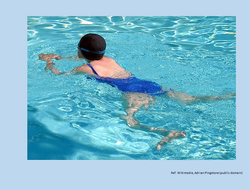Swimming and water based physical activity
Published: January 19, 2023
Swimming is consistently ranked by adults as one of the most popular forms of regular physical activity.
In the past several decades other water based physical activities have also become popular alternatives to land based physical activities such as walking, running and cycling.
Water activities include aquacise, aquarobics (aqua aerobics) and water running.
Water based physical activities can provide similar health benefits as land based physical activities.
Moderate to vigorous intensities peformed for 30 minutes or more at each session can produce significant health benefits.
In some instances, water based physical activity may be superior to land based physical activity.
However, to maximise these health benefits there are several factors to be considered.
Health Benefits of water based physical activity
Water based physical activities are associated with the following health benefits:
- Improved cardiovascular fitness when performed at a moderate to vigorous pace continuously
- Improved muscular strength and endurance due to water resistance
- Improved flexibility
- Improved quality of life
- Reduced risk of chronic disease and death
- Improved joint mobility and reduction in pain for people with osteoarthritis
- Mediates symptoms of rheumatoid arthritis
- Improves mental health in men and women
- Decreases anxiety and depression in people with fibromyalgia
- Improves the health of mothers and their unborn children
- Improves and maintains bone health of post-menopausal women
- Older adults: improves quality of life, decreases disability, improves balance, decreases risk of falling
- May reduce fatigue and improve mobility in people with multiple sclerosis
- May provide a safe form of exercise for people suffering from chronic obstructive pulmonary disease (COPD)
Water based physical activities reduce the load on your skeletal system.
This form of activity may be especially beneficial for the elderly, people with skeletal and muscle injuries, and people who find it difficult to perform land based exercise for extended periods of time.
Water based physical activity may be perceived as more enjoyable than land based physical activity...to learn more link to the full article
Related Topics
Health Physical Capabilities Physical Activity Exercise Fitness Flexibility Muscles Cardiovascular FitnessReferences
1.
Corbin, C.B. & Lindsey, R. (1994). Concepts of Physical Fitness. Dubuque, IA: Wm. C. Brown Communications Inc.
2.
American Council on Exercise (1996). Personal Trainer Manual. San Diego, CA: American Council on Exercise
3.
American Council on Exercise (1993) Aerobics Instructor Manual ACE San Diego, CA
5.
Kim, SB, and O’Sullivan, DM (2013). Effects of Aqua aerobic therapy for Older adults on Muscular Strength, Agility and Balance to prevent falling during gait. Journal of Physical therapy science
6.
Pariser, G, Madras, D and Weiss, E (2006). Outcomes of an aquatic exercise program including aerobic capacity, lactate threshold, and fatigue in two individuals with Multiple Sclerosis Journal of Neurological Physical Therapy, Volume 30, 2
7.
Garrett, M and Coote, S. (2009). Multiple sclerosis and exercise in people with minimal gait impairment – a review Physical therapy reviews, 14 (3)
8.
McNamara, R J. et al. (2011) Water-based exercise in chronic obstructive pulmonary disease. Physical Therapy Reviews. Vol. 16 Issue 1, p25-30.

